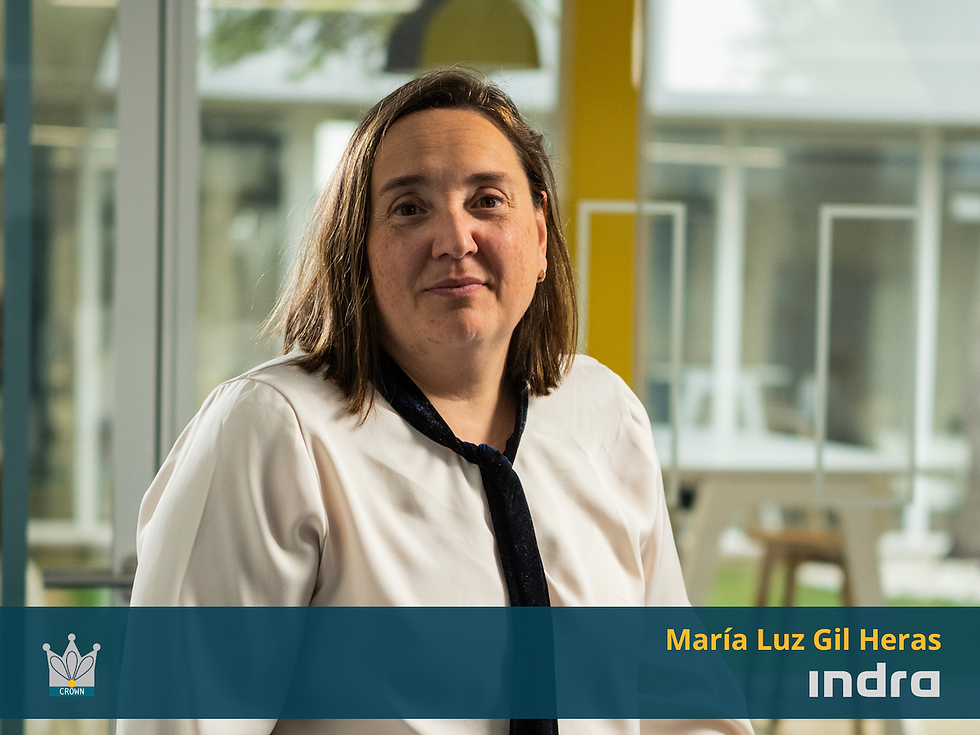CROWN responds to the need of developing high performance and very compact Multifunction RF systems
- info6150017
- Dec 2, 2022
- 3 min read
We are talking with one of the CROWN experts, dr. María Luz Gil Heras from INDRA, who is participating in defence projects in activities of electronic design & development and its integration at system level.

What are the main technical purposes of the CROWN project?
CROWN aims to progress in the development of European Multifunctional RF AESA systems combining radar, electronic warfare, and communication functions. The system will be conceived for aerial platforms, most restrictive in terms of SWaP (Size, Weight and Power), but adaptable to other types of platforms.
There will be work at system level analysing broadband antennas, wideband digital beamforming and sophisticated techniques for resource managing and at component level studying and designing compact transmit and receive modules.These activities will contribute to mature the technology needed for realization of these systems. CROWN will also make an assessment on the supply chain of the critical technologies to assure the development of multifunctional RF AESA systems.
In your opinion, which phase of the CROWN project can be described as having the greatest impact not only on the future development of the project but also on the technology itself?
I would not choose one or another phase. I think within the project structure everything is important.
At system level, the phases defined follow the system engineering methodology. We start collecting the stakeholder needs, defining the concept of operations and system requirements to continue with the system architecture definition and building blocks specifications. Research activities regarding design and development will be accomplished taking into account the main building blocks as antenna, digital beamformer, resource manager and transmit/receive modules that will be designed and developed. It is important to remark that also modelling is part of the scope of the project.
With regards to technology assessment, it is of great importance to identify critical technologies to build the future MF systems, to assure its related supply chain or to identify the future investments needed for this purpose. Perhaps this technology assessment, in the sense of the impact you ask, can have a broader scope and other systems, not only MF, can be benefited also from CROWN results.
What is the significance of the technology developed during the CROWN project in modern/ nowadays defence?
CROWN bets for compact technologies with low weight, low size, low power consumption and for wideband digital technologies that will contribute not only to the realization of multifunction system. A wider range of compact, digital, and intelligent radio frequency systems will be benefited thanks to the technology maturation achieved with the implementation of the multifunction AESA system roadmap. We are talking about future networked, high-performance, and intelligent systems, installed in different platforms, working in a collaborative way in complex multidomain scenarios and facing a wide range of different threats.
What would be the best indicator of success of the CROWN project for you as a scientist?
In terms of technology and performance the most relevant indicators of success will be related to the wideband and digital aspects of the different technology building blocks and its integration to demonstrate the multifunction AESA digital RF system concept.
Another important indicator of success will not be on the technology itself but in terms of collaboration. A team composed by European industries and research centers working together for a common objective. Cooperation is crucial to achieve better improvements within the European defence capabilities and European industrial landscape.
---
María Luz Gil Heras is electronic Engineer by Alcalá University. Engineering Systems Master’s degree by Universidad Europea. PMP certified. She works at the company Indra Sistemas in the department of Transport and Defence since year 2000. She started her career participating in many relevant INDRA defence projects in activities of electronic design & development and its integration at system level. She continued working in European research projects and currently, she is responsible for the Technology Acquisition Group in charge of defining the Technology Strategy within Engineering and Technology Department. Active member of Technologies for Components and Modules (TCM) and RF Sensors Technologies (RFST) Captechs in the European Defence Agency.




Comments